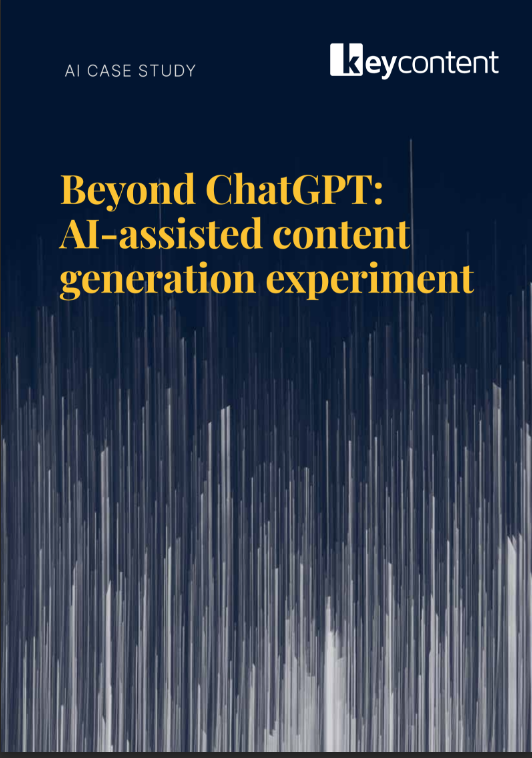While language technology has been in use for a number of years, the new age of AI-generated content has arrived in the mainstream as if from nowhere. Disruption is an over-used term at the best of times, but the potential impact of AI on the content generation industry truly does deserve the description.
On top of automated content, artificial intelligence can produce content in response to simple human instructions or “prompts”. It has also opened up a new world of AI-assisted content, enhanced by skilled human writers.
Let’s examine the differences between the current types of AI content, look at their pros and cons and dare to make a few predictions.
Automated content
Automated content can be likened to using a robot to fetch and present information to the reader. The computer acts on a set of instructions to retrieve the required data and automatically slots it into a pre-defined template that the user sees.
For instance, an air travel aggregation website can automatically create tips on the cheapest fares, quickest flight times and best times to travel. Or a sports site can update itself with live scores.
This method has been used since the late 1990s, and it arguably made mass e-commerce feasible and scalable.
The first impact of automated content
Automatically generated content was an essential technological step forward. Previously, each website page had to be created individually. Automated content population meant that only one page template was required – the underlying code could fetch the information automatically. For example, an online shoe shop can create a product page template, which fills with the relevant content depending on which shoe the user chooses to view.

A content cul-de-sac
However, this method can’t actually create content. The automation relies entirely on human input – it’s only able to fetch and place information where it needs to be. Much like a robot stacking warehouse shelves.
This type of content creation saves vast amounts of time, especially when it comes to handling repetitive tasks. However, it can’t generate intelligible copy by itself.
AI-generated content
This is content largely written by a computer, with minimal human input. It’s where all the current hype lies, creating tsunami-like waves in the content creation industry.
The reason is plain. These tools have the ability to create huge volumes of readable content. The appeal for online marketers is irresistible. Content can be produced at a far higher rate than is humanly possible, giving instant productivity and scalability benefits. And, as with any other industry, automation is more cost effective than human output.
These AI tools[1] work by having a person input prompts, in the form of instructions, topics, keywords and often whole phrases. The tool then searches the Internet for the information it needs to create the content.
The good and the bad of using AI content
AI-generated content can be used for many purposes. It can “write” anything, from marketing materials and product descriptions to in-depth blog articles.[2] However, despite the excitement, this is yet to be true AI, as it still relies almost entirely on human input.
Another drawback is that the content, while informative, lacks human engagement with your brand. Humans can draw on memories, experiences and emotions when writing, which connect with those of the reader. AI is incapable of doing this, which is so important in gaining your customers’ trust and deepening relationships.
AI-assisted content
AI-assisted content is a collaboration between a writer and a machine, working together to produce high-quality content.
The human writer prompts an AI tool to research a topic and stitch together a basic “first draft”. It’s immensely useful, as this is the part of writing that typically uses the most time. A computer can gather in seconds what could take hours for a human to find.

The critical importance of the human touch
This needs to be an iterative process to arrive at the highest-quality copy. Once the writer has polished the draft, the research still needs to be checked for veracity, as not all information found on the Internet is reliable.
[1] Source: https://en.ax-semantics.com/blog/automated-content-creation-how-it-works-10-tools-2023/
[2] Source: https://buffer.com/resources/ai-content-creation/
With an informative, cogent and readable article now ready, the writer imbues it with all the necessary human elements to engage readers. This is the crucial part, as it addresses the biggest drawback of AI content – the lack of human touch. People are still averse to trusting AI-created content. They want to feel connected to a person just like them, who understands their needs at a human level.
Where are we with AI-generated content right now?
There’s only one way to describe the current state of AI-generated content – in flux.
On the one hand are the doomsayers, predicting that AI will wipe out the entire human writing industry. On the other are dozens of professionals enthusiastically embracing the time savings and cost efficiencies of the technology, including writers.
At the same time, to dust off a hackneyed phrase: the more things change, the more they stay the same. As Google itself says, the focus will always remain on quality. Content needs to be relevant, authoritative and – importantly – original. It must put people first, not just information.
AI content is often still lacking in some other areas too. Inaccurate information is frequently returned, and the tools are entirely dependent on content that already exists elsewhere. The “rubbish-in, rubbish-out” principle clearly applies here.
The upshot is that we are in a world where AI can do much of the heavy lifting for us, but it still needs plenty of human intervention to produce compelling content that connects with human emotions, and ultimately converts.
Where is this all going?
It would be utter folly to even try and predict where AI-generated content will lead us. But there are at least a few ideas in which we can all be confident.[1]
First and foremost, AI content is here to stay. It’s a truism that once technology is released to the public, there’s no taking it back. However, it’s not likely to fully replace humans when it comes to content creation. It will remain an important tool that enhances human work, streamlines it and takes care of the more onerous, repetitive and less creative tasks.
As for the actual tools, OpenAI and ChatGPT are themost popular at the moment, but there are many others like Jasper and Copy.ai. In addition, it is expected that new tools – or indeed full platforms – will evolve in the future,.
On the SEO side, you can be assured that Google and other search engines are looking at mechanisms to detect AI-written content not written for human consumption. So don’t be tempted into using AI to produce masses of content marketing material to improve your website’s rankings,Define your priorities and objectives and who your customers are, and create content with them first in mind, to avoid compromising growth.
We’re in for an exciting and innovative time. The best way right now to discover how AI can help your business with a content generation is to consult companies like Key Content. We’re already deeply immersed in this and can help guide you to the best AI tools to use for your business.
[1] Source: https://www.techtarget.com/whatis/feature/Pros-and-cons-of-AI-generated-content



